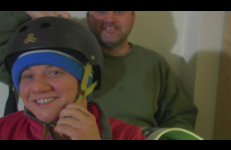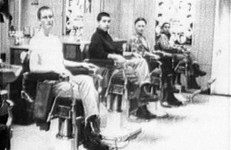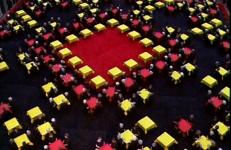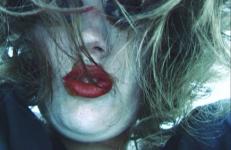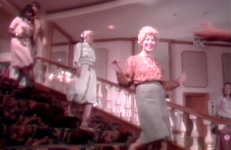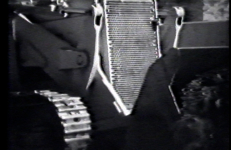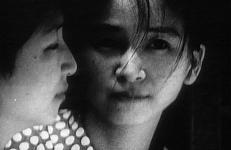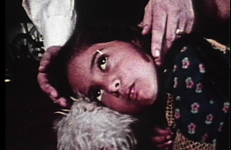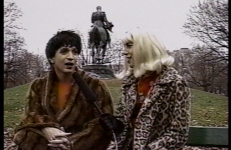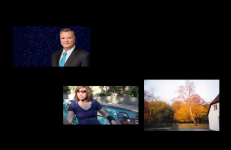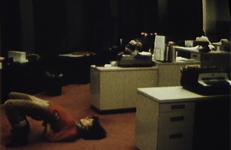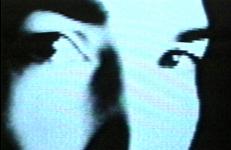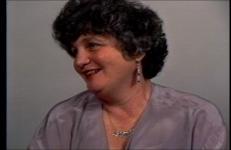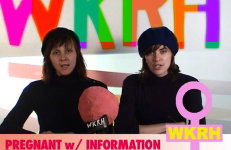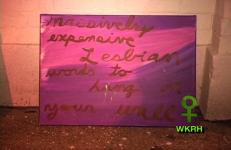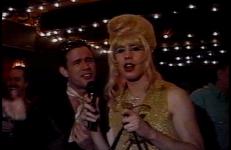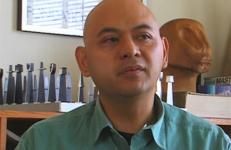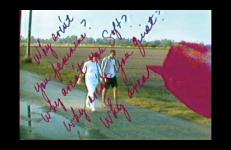LYNDALE is a story of shifting family dynamics, told through the relationship of two brothers. Shot on ten different video formats, this experimental documentary is both the story of a Chicago family, and a record of the digital revolution in the early 2000s. The piece takes place over a six-year period during which filmmakers Oli Rodriguez and Victoria Stob shared a house with Rodriguez’s brother, Jeff.
Gender
LYNDALE is a story of shifting family dynamics, told through the relationship of two brothers. Shot on ten different video formats, this experimental documentary is both the story of a Chicago family, and a record of the digital revolution in the early 2000s. The piece takes place over a six-year period during which filmmakers Oli Rodriguez and Victoria Stob shared a house with Rodriguez’s brother, Jeff.
This experimental Pixelvision piece explores the tenuous boundaries of gender through a series of mini-sequences, among them a group of anecdotes told by women who have been mistaken for men and a must-see synchronized barbershop scene.
This experimental Pixelvision piece explores the tenuous boundaries of gender through a series of mini-sequences, among them a group of anecdotes told by women who have been mistaken for men and a must-see synchronized barbershop scene.
Set in the industrial suburbs of Beirut, Majnounak (Crazy of You) explores male sexuality through interviews with three men who are asked to recount very openly the beginning, middle, and end of a sexual relationship they have experienced. The video explores the image they wanted to project of themselves, hence the image of the "male" they identify with. Their stories are alike, starting with seduction and ending after sex.
From The Crystal Quilt performance, Suzanne Lacy, Phyllis Jane Rose, Nancy Dennis, Sage Cowles, Minneapolis, 1987.
"Mama mama mama...," a woman calls out again and again, over and over. Is it her child that she mimics, or is she calling for her own mother? A desperate video performance in the first person.
This fictional docudrama—based in part on the careers of Anita Bryant, Phyllis Schlafly, and Marabel Morgan—covers the fictitious assassination of Clovis Kingsley, a powerful, pro-family, anti-feminist ideologue, and fictional author of The Power of Total Submission. The narrative is reconstructed in fractured and contradictory flashbacks by those who knew her best and liked her least. The tape travels beyond the faux biography to suggest that the logic of anti-feminism is a strategy of the disempowered.
In Manpower, a bulldozer, a screaming man and a crying baby are among the images that Tanaka combines with a suggestive soundtrack to create an eerie portrait of male strength and weakness.
Through a catalogue of looks, movements, and gestures, Mayhem presents a social order run amok in a libidinous retracing of film noir conventions. Sexuality flows in an atmosphere of sexual tension, danger, violence, and glamour; antagonism between the sexes is symbolized in the costuming of women in polka dots and men in stripes. Censored in Tokyo for its use of Japanese lesbian erotica, this tape creates an image bank of what signifies the sexual and the seductive in the history of imagemaking, pointing to the way we learn about our bodies, and how to use them from images.
Child masterfully composes a rhythmic collage of symmetries and asymmetries in a fluid essay that forefronts the treatment of the body as a mechanized instrument — placing the body in relation to the man-made landscape of factories, amusement parks and urban office complexes. Vocals performed by Shelley Hirsch.
An interactive CD-ROM inspired by the lives and work of ten famous women: Josephine Baker, Simone de Beauvoir, Catherine the Great, Colette, Marie Curie, Marlene Deitrich, Isadora Duncan, Frida Kahlo, Margaret Mead, and Gertrude Stein. The CD-ROM is an investigation into the intersecting economies of sexuality, authorship, eroticism, and gender that inform the lives of women. Their identities are configured in the negotiated space between self and other, a negotiation that continues in Tamblyn's relationship to them as narrator.
Originally presented as a live performance piece using actors, multiple monitors, and music, Modern Times is a consolidation of seven short chapters in the life of a modern woman. In the first sequence, the objects in a suburban home are inventoried: "nice couch," "nice car," and so on — ending with the titles "nice concept," "nice image" — and unmasking this materialistic world as an impossible consumer fantasy. In the next scene, an attractive man sunbathes.
In Mondo Toronto, Glennda travels to Toronto to visit Liza LaBruce (Bruce LaBruce). Liza gives Glennda a tour of the city's public parks, with specific reference to their role in gay culture. Following this, Glennda attends a party that LaBruce is hosting and interviews partygoers, including Scott Thompson from The Kids in the Hall and Amy Nitrate.
A.L. Steiner’s video More Real Than Reality Itself expands the structures of documentary works while challenging its conventional reliance on linear narratives. This critique takes shape through Steiner’s reconsideration of the history of political activism and its representations — configuring a story that emphasizes the embodied, romantic aspects of activism rather than a singular, dominant history.
Mutiny employs a panoply of expression, gesture, and repeated movement. Its central images are of women: at home, on the street, at the workplace, at school, talking, singing, jumping on trampolines, playing the violin. The syntax of the film reflects the possibilities and limitations of speech, while “politically, physically, and realistically” flirting with the language of opposition.
My Failure to Assimilate muses on the profound sense of melancholy that sets in after the end of a relationship. The tape uses poetry, songs, collage, interviews, and narrative elements to construct a complex picture of the resulting loss of direction and loss of identity. The tape is organized into three sections: Part 1: 'Schizophrenia'; Part II: 'Alienation'; and Part III: 'True Self'. Central to the question of identity is the interplay between imaginary and symbolic identification.
—Maria Troy and Thompson Owen
In 1973 Joan Nestle co-founded the Lesbian Herstory Archives, an essential collection of documents, writings, and artifacts of lesbian cultural history. In 1979 she began writing erotic stories and has published two collections of writings: A Restricted Country (1987) and A Fragile Union (1998). She took a controversial stance in opposition to the 1980s feminist anti-pornography movement, thus becoming a fervent pro-sex activist in the “Sex Wars.” Interview by Nina Levitt.
In New Report, Wynne Greenwood and K8 Hardy are reporters at WKRH - the feminist news station that is "pregnant with information." As Henry Irigaray (Hardy) and Henry Stein-Acker-Hill (Greenwood), these two lesbian feminist artists stage reports on and with their friends, their social herstories, their nerves, and their bodies. It is urgently broadcast live to the newsroom and out to their studio audience.
In New Report, Wynne Greenwood and K8 Hardy are reporters at WKRH - the feminist news station that is "pregnant with information." As Henry Irigaray (Hardy) and Henry Stein-Acker-Hill (Greenwood), these two lesbian feminist artists stage reports on and with their friends, their social herstories, their nerves, and their bodies. It is urgently broadcast live to the newsroom and out to their studio audience.
The second installment of the collaborative project New Report, an ongoing series of performances and videos, Artist Unknown features K8 Hardy (founder of the queer feminist art collective LTTR) and Wynne Greenwood (of Tracy and the Plastics) playing Henry Irigaray and Henry Stein-Acker-Hill, and anchor and roving correspondent for WKRH, a feminist TV news station whose tagline is "pregnant with information." Based on documentation of a live, digital communication in real time between Greenwood at Foxy Production Gallery and Hardy on the street in New York.
The second installment of the collaborative project New Report, an ongoing series of performances and videos, Artist Unknown features K8 Hardy (founder of the queer feminist art collective LTTR) and Wynne Greenwood (of Tracy and the Plastics) playing Henry Irigaray and Henry Stein-Acker-Hill, and anchor and roving correspondent for WKRH, a feminist TV news station whose tagline is "pregnant with information." Based on documentation of a live, digital communication in real time between Greenwood at Foxy Production Gallery and Hardy on the street in New York.
In this episode of Glennda and Friends, Glennda Orgasm and Mark Allen drink at Marie's Crisis Café, a piano bar in Manhattan. They interview other bar patrons and discuss topics including politics, Judy Garland, and the idea of mid-life crisis.
An episode of Glennda and Friends, hosted by Glennda Orgasm and Mark Allen.
The popular images of Asian American males, historically propagated in the mass media, range from "silent, sex-less, obedient houseboy" to "mystic martial arts master". Invisibility has been a core element in the public’s perceptions, and is reflected in the one-dimensional representation of Asian men. This is a program by and about Asian-American men. Through their experiences and voices we become privy to the peculiar and insidious ways in which racism affects their evolving self-identities.
No More Nice Girls layers the personal and political histories of women active in the 1970s feminist art movement, including Brenda Starr, Yvonne Rainier, B. Ruby Rich, Carrie Mae Weems, and Sherry Millner. Set in the mid-1980s, when many of the advances of the women’s movement were threatened by backlash conservatism, this video forefronts conversations between feminists over a collage of archival photographs, newspaper headlines, and bumper stickers that recollect a feminist history in danger of erasure.
" … Brilliantly written and realized”




